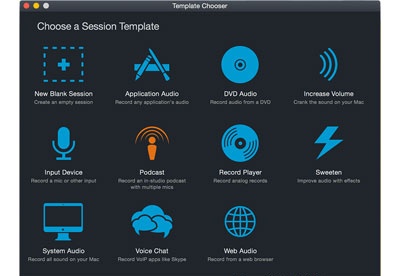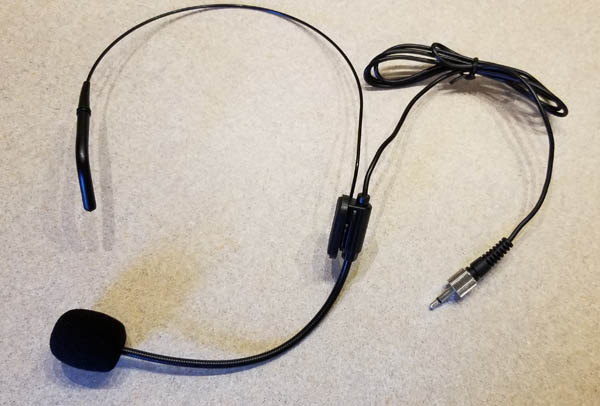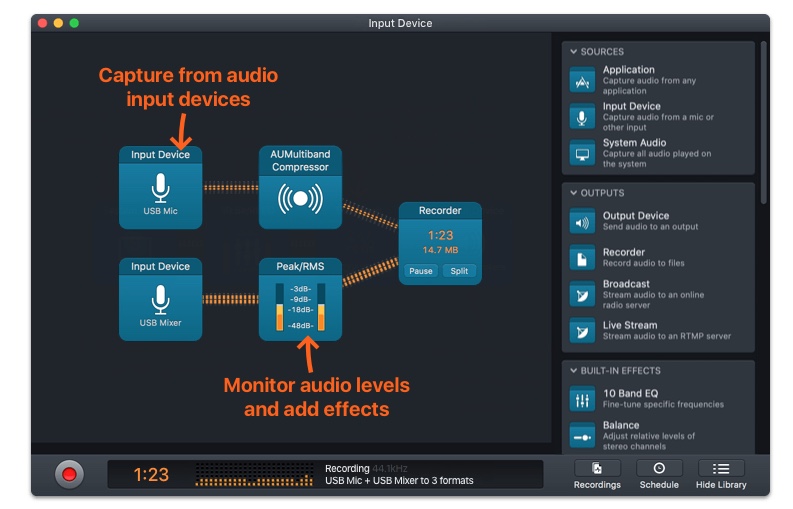
- EXAMPLE AUDIO HIJACK MICROPHONE SETUP FOR FREE
- EXAMPLE AUDIO HIJACK MICROPHONE SETUP INSTALL
- EXAMPLE AUDIO HIJACK MICROPHONE SETUP PRO
- EXAMPLE AUDIO HIJACK MICROPHONE SETUP SOFTWARE
- EXAMPLE AUDIO HIJACK MICROPHONE SETUP TV
Let’s start with creating a new blank session: It’s broken into three tabs: “Sessions”, “Recordings”, and “Schedule”. The interface for Audio Hijack is remarkably easy to use.
EXAMPLE AUDIO HIJACK MICROPHONE SETUP INSTALL
When you first open Audio Hijack it’ll ask to install some helpers which we’ll need for this setup. Secondly, we’ll get Audio Hijack set up to handle your audio. I won’t walk through the whole Dante setup, but go ahead and start the soundcard and make sure you have it connected to the right network and configured with the correct amount of I/O channels for your setup. If you’re using a physical audio interface, you’ll have to connect that and install any related drivers.
EXAMPLE AUDIO HIJACK MICROPHONE SETUP SOFTWARE
During our services it runs ProPresenter for slides and videos, and iTunes for background music playback, but whatever software you use should work fine with today’s setup.įirst, you’ll need to install Audio Hijack (you can get a free version that works for 10 minutes) and, if you’re following along with Dante, the Dante Virtual Soundcard. It has a 2.66 Ghz Quad-Core Xeon, 16 GB of RAM, and an NVIDIA GeForce GT 120. In our case, we bought an old early 2009 Mac Pro. Let’s start with the source and final destination of our audio: the media computer. Configuring the Media Computer for Dante I/O (using Audio Hijack) I also wanted to send the following from our sound board to our media Mac for recording:

Our I/O Setupįor us, I wanted to have the following outputs routed individually from our media Mac to our sound board: It gives a huge amount of flexibility, zero noise and–in my experience–reliability over typical USB or Thunderbolt audio interfaces. If your primary audio console supports Dante, I’d highly recommend you take a look at my other post to see if it might be a good option for you.

The downside is that you’ll have to run cables for every input and output you use. You could certainly use a USB or Thunderbolt audio interface to accomplish the same goal. I wrote a seperate post on Audinate Dante and how we use it here, but in this blog post, Dante is simply acting as our audio interface. It’s flexible, reliable, and keeps us from having to purchase, manage, and maintain separate devices for each of those functions.
EXAMPLE AUDIO HIJACK MICROPHONE SETUP PRO
Hopefully, that has led you to find creative ways to stretch every dollar and squeeze every ounce of capability out of each piece of valuable equipment you have.This blog post is about how we use Audinate Dante ($29.99 per computer, plus a device that can function as a master clock) and Audio Hijack ($59) to allow a single early 2009 Mac Pro to perform the functions of video playback (with ProPresenter), background music playback (with iTunes and/or Spotify), and backup audio recording for our services. Much better than Quicktime (delay) or any other trick I tried.As Craig Groeschel says, innovation is often borne out of limitations, and as many of you know as volunteer audio/video techs for a small church: limitations abound.
EXAMPLE AUDIO HIJACK MICROPHONE SETUP TV
The sound is perfectly synched to the TV (no delay) and to avoid any irritating white noise in the background we simply unplug the computer’s power cord and run it on battery mode. Now when I travel and my wife or I want to watch Hotel TV while the other doesn’t, to use headphones (you'll need to bring along a fairly long mini plug cable) she or I can just plug my laptop into the TV’s “speaker out” port via the computer’s line in mini plug port (my laptop has two mini ports, unlike the newer models) and the headphones into the computer’s audio out port.

Once opened up, just click on "Play Through". ) It works perfectly on my Powerbook (OS El Capitan).
EXAMPLE AUDIO HIJACK MICROPHONE SETUP FOR FREE
(You can download MTCoreAudio for Mac for free at. I tried several things and was getting pretty frustrated until I discovered an old 2010 article by Adam Dachis about using AudioMonitor, part of MTCoreAudio’s developer package for Apple products. If necessary, adjust the system's overall input and output volume settings in System Preferences → Sound → Input. In the new "Untitled" window that opens, ensure the icon at the bottom says " Audio Engine Running" (or click to toggle if it says "Audio Engine Stopped"). (If the Document Configuration window is not already open, click File → New to open it.) Then click the Create Document button in the bottom right corner. In the Document Configuration window, select the existing " Stereo In/Stereo Out" configuration.


 0 kommentar(er)
0 kommentar(er)
